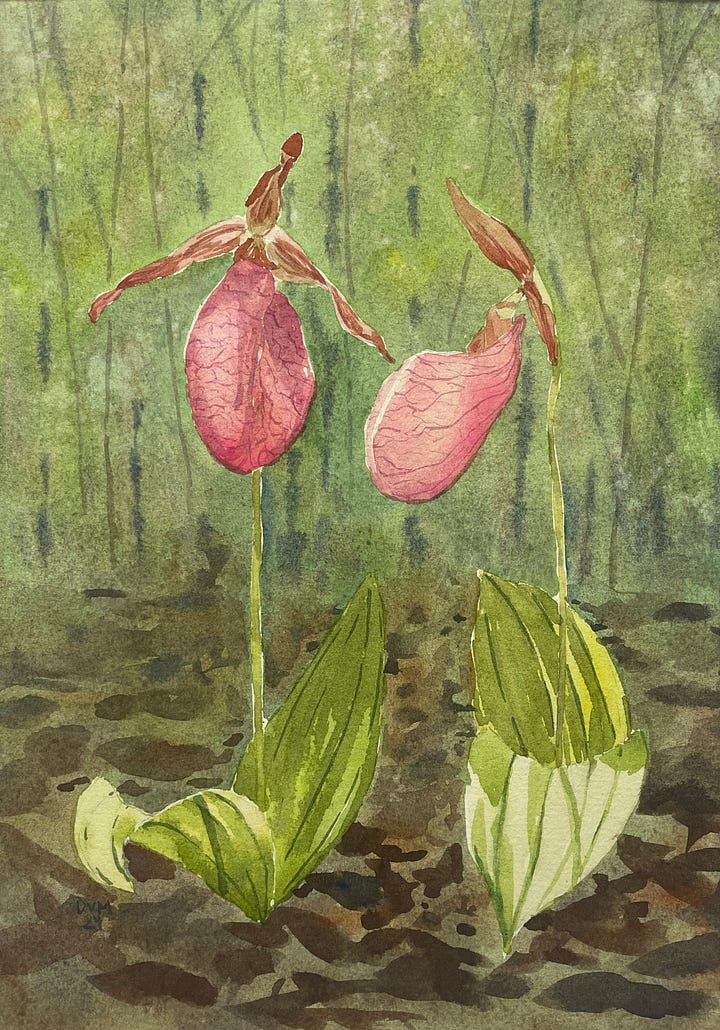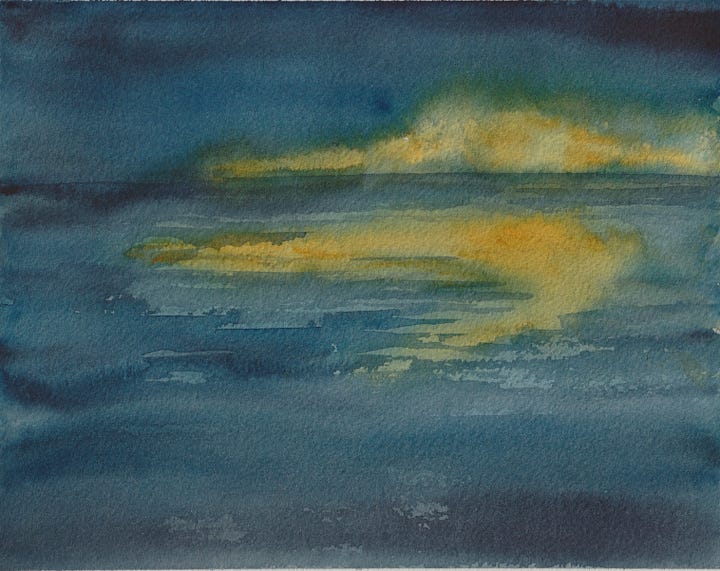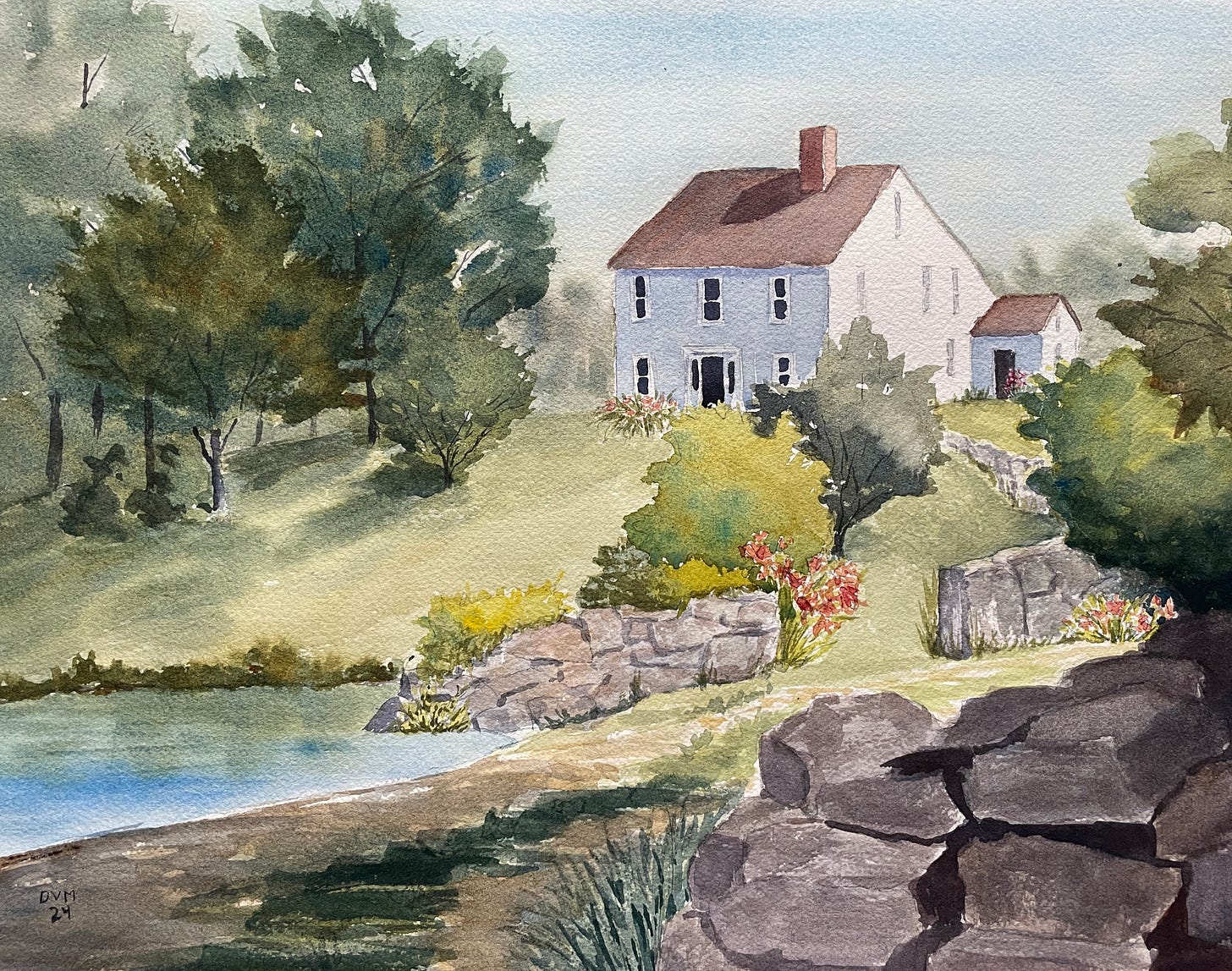September Updates: Back to School Edition
Thoughts on teaching in a post-pandemic, AI-crazy world, art on view now, and fall writing workshops!
“O, wonder!
How many goodly creatures are there here!
How beauteous mankind is! O brave new world,
That has such people in’t!”
~Shakespeare, The Tempest, Act V Scene 1
After more than two decades in the classroom, I know I still belong in the classroom because in the middle of August, I found myself at my desk every day, in spite of some truly beautiful August weather—cool mornings and evenings, balmy afternoons, sunshine, breezes rippling the trees— preparing for the school year ahead.
Maybe, after over twenty years of teaching, you’d think I have nothing I need to prepare during the summer months. Surely I know what I am doing by now. I must be able to just roll in the first day, flip open my notes from last year like switching on autopilot, and go. And I suppose I could do that, but if I did, that would be a sign that I no longer belonged in the classroom, actually. If I felt that there was nothing I could do differently, nothing I could improve upon, nothing new I could add, to me that would be a sign that I was no longer engaged in my work, and it would be time to pack it in. This year, though, I don’t just want to do some things differently. I want to do almost everything differently.
I treaded water through the crises in education over the past few years brought on by the double whammy of the pandemic and rise of large language model AI, and honestly I don’t know how I didn’t drown. Somehow I didn’t wash out of education like so many other excellent teachers. Instead, I have arrived, exhausted and sputtering on some inhospitable shore, surveying the jetsam and flotsam that has washed up alongside me, and I know that there’s no going back. I must find a way forward in this brave new world, and my old maps won’t help me now. I have to chart new ones.
I think I can say without boasting that I have been a good teacher throughout my career. I may even have had flashes of greatness. From a solid foundation of loving my subject matter and caring about my students, I have done my best to impart information and provide authentic opportunities for learning.
When I began teaching, technology had not yet taken over the classroom, but it was beginning to creep in, and I embraced it, seeking ways to augment my lessons and activities. I had students built wikis and make podcasts and videos. I had them use software to make infographics and other creative projects. Because I believe I should never ask my students to do something I myself cannot do, I learned website design, video and audio editing, graphic design basics. I tried to stay on top of best practices and keep my classes fresh.
Now, though, having survived the COVID/AI shipwreck, I look back and see that, in the ignorance of those blissful pre-pandemic days, I strayed from the essentials of education and had wandered into a carnival. Bells and whistles everywhere, and what at first glance looked fun and exciting proved, upon closer inspection, to be at worst distractions and at best pastimes, not quite a waste of time, but close.
From my new vantage point, I can see that what my students need is not a tilt-a-whirl or game of whack-a-mole (although a Ferris wheel would be alright—who wouldn’t benefit from taking the long view every now and then?). What they need is a calm harbor in a chaotic world. And that’s what I need, too.
So, on a beautiful August afternoon, I sat at my desk. Taking a page out of Lynda Barry’s book, I shut my computer, took out an old-fashioned marbled notebook, and began to write out my classroom policies by hand, embellishing the text with doodles and stenciled headings, using markers and colored pencils, and having far too much fun to feel as if I was wasting a summer day working. While writing by hand is slower than typing and less efficient in terms of the ability to edit and revise one’s work, it has advantages, too.
First, one of my goals for this school year is to keep things simple.
Classroom activities, instructions, grading rubrics—all of this can be simple, but over the years mine have gotten increasingly complicated and convoluted. That’s what happens with two decades of adding-on. What once were assignment instructions with three steps have ballooned to nine steps with several sub-steps each. Rubrics that once had five points now have a dozen.
The tedious specificity of my instructions and rubrics grew out of a desire to be clear and efficient, but in most cases probably had the opposite effect. Students were overwhelmed with long and complicated instructions. Even though I was thinking I was making it simple—Go step-by-step, in order!—it’s not easy to relax and go step-by-step when faced with pages of single-spaced instructions, is it? Anyone who has ever tried to assemble Ikea furniture knows the answer to that one, and yet, somehow I couldn’t see it.
I was bogged down in unimportant minutiae when grading with my detailed rubrics so that everything took longer and I was less satisfied with the correlation between students’ grades and the quality of their work. Students often didn’t know how to use the rubrics as feedback and therefore didn’t benefit from my labor anyway. More, more, more turned out to be less, less, less.
Writing out instructions by hand is helping with the problem of overcomplicated instructions and rubrics. Quite simply, I write less when I write by hand. Instead of saying absolutely everything I can think of in a frenzied brain dump like I do when typing, I have to take my time and think about what the most important things are. I can always offer more detail in the verbal instructions I give in class, which is another advantage: Kids have more incentive to listen! When I write out everything in micromanager mode, I am not giving the kids a lot of incentive to listen to me in class.
Second, another of my goals this year is to foster community in my classroom and build strong relationships with my students. Writing by hand is a way of infusing my personality into my work. Typed handouts can be so cold and impersonal. My handwritten ones are anything but impersonal. I found myself filling up empty space in pages with doodles and fun facts, quotes I like, and so on. Unlike the old adage that teachers shouldn’t smile until after Christmas, I want to be my authentic—happy!—self with my students from day one.
And third, by writing by hand, I am modeling something I want my students to do. I give a lot of no-computers-allowed assignments, from mundane things like quizzes to creative things like making comic strips. I want students to see that work by hand is not busywork or merely a way to prevent them from using AI. Writing by hand is a way of thinking with your pen. It’s something I actually do, and I want them to see that I practice what I preach.
I know I won’t be able to write all my assignments by hand with color coding and embellishments all year, but as much as possible, I want my school year to be a low-tech one, for my students and myself. I want no screens between us. I will build relationships by closing my computer and focusing my attention on the faces before me.
This brave new world doesn’t have to be a scary one, if I focus on how many goodly creatures there are.
Note: I have been wanting to write about teaching for quite a while now, and have done so in fits and starts, but haven’t shared much of it. I am thinking of posting some of my musings to the “Blog” section of my substack, so if you enjoyed the reflections above, please check your subscription settings and be sure to add my blog to posts you receive by email. And if thoughts on teaching aren’t relevant for you, no worries, just check your subscription settings and be sure that you are only subscribed to my monthly newsletter instead :)
Art News
I am excited to share that my painting, Crystal Brook Farm, will be on view at the New England Watercolor Society in Plymouth, MA, from September 6 through November 6 as part of the annual Associate Member Exhibit.


I also have two works—Lady Slippers (9x12 watercolor on paper) and Ogunquit Nocturne (8x10 watercolor on paper)—in the Rhode Island Watercolor Society’s Small Works show, which runs from September 7 to September 28. If you’re in the Pawtucket/Providence area, check it out!
And finally in art news, I’m going to be participating in the third annual plein air competition in Arlington, MA on September 21 as part of their “Old Town Day” festivities. I’m very excited as this one required artists to apply—and I got in! My artful summer began at a plein air competition in North Attleborough in June and it will end with one in Arlington in September, perfect bookends.
Painters will be working from about 10:30 AM to 1:30 PM, with judging around 3:30. All this is taking place around The Winfield Robbins Memorial Garden, so if you’re in the area, come by, check out the festivities, and see artists at work!
Fall Writing Workshops
This fall, I am running a National Novel Writing Month workshop series at both the Morse Institute Library in Natick, MA and the Groton Public Library in Groton, MA. We’ll meet in October to plan and prepare, in November to keep up our momentum, and in December to talk next steps! Join us for all three or just one.
Get all the details and dates on my website!






